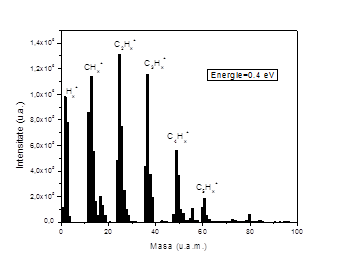"PROCESS DIAGNOSTIC: CARBON NANOWALLS VERSUS CARBON NANOFIBERS PLASMA DEPOSITION" |
IDEI |
|
Stage I. Integration of diagnostics techniques (OES, Langmuir probes, mass spectrometry) with the deposition setup
Stage objective
The main objective of this stage consists in
The main objective of this stage is to achieve a deposition system for carbon nanowalls and nanofibers like material integrated with diagnostic techniques (emission spectroscopy, Langmuir probes, mass spectrometry) suitable for the deposition process. The operation of the system will be validated by the diagnostic data acquisition in typical conditions for the studied carbon materials deposition.
Representative imagies associated to the results obtained in the first stage of IDEI_81 project
|
|
Figure 1: a) sketch and b) image of the experimental set-up used for carbon nanowalls deposition and plasma diagnostics
|
|
|
Figure 2: a) top-view and b) cross-section SEM images of carbon nanowalls obtained in typical conditions
|
|
|
Figure 3: Typical emission spectrum for the plasma jet in standard condition for CNW deposition
|
Figure 4: Example of experimental and simulated spectra for C2 molecular band (516nm)
|
|
|
Figure 5: a) probe characteristic and b) electron energy distribution function for optimal conditions of carbon nanowalls deposition
|
|
Figure 6: 3-D representation in mass-energy-ion intesity coordinates in optimal conditions of carbon nanowalls deposition
|
 |
 |
Figure 7: Mass spectrum of ionic species present in plasma for a certain energy
|
Figure 8: Energetic spectrum of plasma species corresponding to a certain mass
|
|
Figure 9: Mass spectrum of neutrals in plasma used for carbon nanowalls deposition
|
Conclusions
In this stage we made an experimental set-up for nanostructured carbon material deposition, in that we integrated a low frequency radio-frequency plasma source and plasma diagnostic systems. The experimental system was tested for the ability to synthesize carbon nanometric walls. In the SEM images could be seen that obtained two-dimensional structures are well defined and separated from each other, with sharp edges and high area/volume ratio. The investigation of the plasma species was conducted simultaneously by complementary techniques following:
- species with short life time (optical emission spectroscopy)
- charged species – ions, electrons (Langmuir probes)
- species with long life time (mass spectrometry)
Measurements have shown that diagnostic systems are functional and provide meaningful data on the physical properties of the deposition environment (nature and relative concentration of species and their energies).
|

